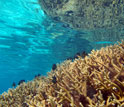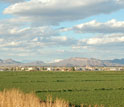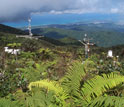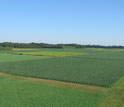Media Advisory 12-002
NSF Forum: The Challenge of a Sustainable Future: Long-Term Ecological Research Offers New Answers
Scientists address sustainability of agriculture; urban water systems; indigenous villages; marine environments

Sustainability at NSF's Bonanza Creek LTER site in Alaska. Artwork by Karen Franzen.
February 7, 2012
This material is available primarily for archival purposes. Telephone numbers or other contact information may be out of date; please see current contact information at media contacts.
From Canada to Chile, from Kazakhstan to Kansas, we are witnessing a fast-changing planet. What will it look like in the years, decades and centuries to come?
How far, and in what ways, can Earth's systems be stressed before they undergo transitions to new states--with unforeseen consequences?
For most of its history, Earth experienced vast alterations in response to natural, planetary variations, says Saran Twombly, program director for the National Science Foundation's (NSF) Long-Term Ecological Research (LTER) Network. Humans, however, are now emerging as the dominant agent of change.
The world is at a crossroads, say scientists. With growing problems such as resource depletion, energy sustainability, environmental degradation and climate change, how can people protect the health of the planet while achieving widespread economic prosperity?
Scientists say the answer is a sustainable world, one in which human needs are met without harm to the environment and without sacrificing the ability of future generations to meet their own needs.
To respond to this challenge, more information is needed about how the natural world, society and human alterations to the environment fit together.
On Thursday, March 1, 2012, NSF will host a symposium titled "How Long-Term Ecological Research Informs Sustainability Science and Action."
The meeting is the 11th such annual NSF symposium to address topics in long-term ecological research.
Scientists across NSF's LTER Network look at new ways of asking and answering questions about a sustainable future: where have we been, where are we going, and how do we best get there?
We must move beyond identifying issues and toward providing sound bases for the development of innovative solutions, as well as toward effective adaptation and mitigation strategies, these scientists believe.
Presentations at the symposium will address the sustainability of agriculture in view of biofuels markets; resilience in marine environments; graduate education on sustainability science; local knowledge of sustainability and resilience in indigenous villages; urban water sustainability; how to build knowledge and action systems in urban areas; and using the landscape to mitigate vulnerability and enhance resilience.
Scientists from several NSF LTER sites will discuss how to address sustainability challenges in the shadow of the huge global footprint produced by humans.
NSF's LTER Network spans the Arctic to the Antarctic to the tropics. The 26 sites represent Earth's major ecosystems, and include grasslands, forests, tundra, urban areas, agricultural systems, freshwater lakes, estuaries and salt marshes, coral reefs, coastal zones and the open sea.
A special feature of this year's symposium is an exhibit titled "Long-Term Ecological Reflections."
Several LTER sites support collaborations between scientists and artists. Projects explore the past, present and future scenarios of land use and environmental change. "They inspire broad audiences to a deeper understanding of the natural world," says Twombly.
The exhibit features a collection of ecological reflections from three LTER sites: Bonanza Creek in Alaska; Harvard Forest in Massachusetts; and North Temperate Lakes in Wisconsin. It will be displayed in NSF's exhibit space on the third floor.
| Who: | LTER Scientists |
| What: | Symposium on sustainability science and long-term ecological research |
| When: | Thursday, March 1, 2012, 8:30 a.m. to 12:00 p.m. |
| Where: | National Science Foundation, 4201 Wilson Blvd., Room 110, Arlington, VA 22230 |
Detailed Agenda:
Moderators: Scott Collins, Chair, LTER Science Council (University of New Mexico, Sevilleta, Konza Prairie, Central Arizona-Phoenix LTERs), and Dan Childers, Chair, Symposium Organizing Committee (Arizona State University, Central Arizona-Phoenix LTER)
8:30 a.m. Welcome and opening remarks
Saran Twombly, NSF LTER Program Director, NSF Division of Environmental Biology
8:45 a.m. Agricultural sustainability and nitrous oxide markets
Phil Robertson (Michigan State University, Kellogg Biological Station LTER)
9:10 a.m. Managing for resilience in benthic marine environments
Russ Schmitt (University of California at Santa Barbara, Moorea Coral Reef LTER)
9:35 a.m. Innovations and lessons learned in distributed graduate education on sustainability science
Jeannine Cavender-Bares (University of Minnesota, Cedar Creek LTER)
10:00 a.m. Local knowledge for the study of sustainability and resilience in indigenous villages of northern Alaska
Gary Kofinas (University of Alaska, Bonanza Creek LTER)
10:25 a.m. Break
10:40 a.m. Urban water sustainability
Claire Welty (University of Maryland - Baltimore County, Baltimore Ecosystem Study LTER)
11:05 a.m. Building knowledge-action systems for urban sustainability: interdisciplinarity and reflexivity in San Juan ULTRA-Ex
Tisha Muñoz-Erickson (Arizona State University, Luquillo LTER)
11:30 a.m. Using the landscape to mitigate vulnerability and enhance resilience
Billie Turner II (Arizona State University; Central Arizona-Phoenix LTER)
11:55 a.m. Concluding remarks
12:00 p.m. Adjourn
-NSF-
-
NSF's Long-Term Ecological Research sites criss-cross the globe from pole to pole.
Credit and Larger Version -
Resilience in locations such as NSF's Moorea Coral Reef LTER Site is critical to sustainability.
Credit and Larger Version -
Research on landscapes and vulnerability at NSF's Central Arizona-Phoenix LTER site.
Credit and Larger Version -
Urban sustainability knowledge-action systems are a focus at NSF's Luquillo LTER site.
Credit and Larger Version -
Scientists at NSF's Kellogg Biological Station LTER site studying agricultural sustainability.
Credit and Larger Version
Media Contacts
Cheryl Dybas, NSF, (703) 292-7734, email: cdybas@nsf.gov
Related Websites
NSF LTER Network: http://www.lternet.edu
NSF Science, Engineering and Education for Sustainability Investment: http://www.nsf.gov/funding/pgm_summ.jsp?pims_id=504707
The U.S. National Science Foundation propels the nation forward by advancing fundamental research in all fields of science and engineering. NSF supports research and people by providing facilities, instruments and funding to support their ingenuity and sustain the U.S. as a global leader in research and innovation. With a fiscal year 2023 budget of $9.5 billion, NSF funds reach all 50 states through grants to nearly 2,000 colleges, universities and institutions. Each year, NSF receives more than 40,000 competitive proposals and makes about 11,000 new awards. Those awards include support for cooperative research with industry, Arctic and Antarctic research and operations, and U.S. participation in international scientific efforts.
Connect with us online
NSF website: nsf.gov
NSF News: nsf.gov/news
For News Media: nsf.gov/news/newsroom
Statistics: nsf.gov/statistics/
Awards database: nsf.gov/awardsearch/
Follow us on social
Twitter: twitter.com/NSF
Facebook: facebook.com/US.NSF
Instagram: instagram.com/nsfgov





